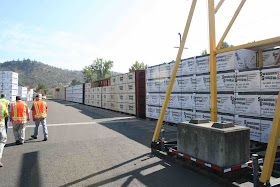An important
track feature needed for the Oakridge Yard was noted as soon as we started operation
on the full mainline of my SP Cascade Line last year. With my original track arrangement, helpers
had to be cut into RR-West trains at the RR-West end of Oakridge. This tied up the entire yard throat, yard
tracks, and the Salmon Creek block—the next operating block RR-West of
Oakridge. One of my retired SP engineer
operators was serving as a helper engineer, and noted: “ Hey Bill, weren’t
there crossovers in the yard?”
I laid out my
Oakridge Yard using a track diagram from Austin and Dill’s “Southern Pacific in
Oregon” book (PFM, 1987). The same
diagram also appeared in the meet booklet for the Espee in Oregon Meet held in
Oakridge in about 2005. Both diagrams ended at
the Crestview Street overpass—roughly halfway into the yard, but encompassing
the depot and engine facilities, including the wye. I failed to study closely the map on the
aforementioned Oakridge Meet booklet which confirmed the crossovers RR-East of the
Crestview Street overpass (off the diagram).
Operations logic should have alerted me to the need, as well.
The operational
need has been compelling. Adding the
missing crossover switches has been on my short list of high priority track
projects. Not only do the mid-train
helpers need the crossovers, but the Oakridge Turn could use them to good
advantage as well. I needed a couple of
months’ break from operations to do this task, something created by my schedule
conflicts this Fall.
The revised Oakridge
track schematic shows the function of the crossovers. RR-West trains can use the Pope and Talbot spur
as a switch lead to help clear space for the helpers. This lead is regularly used by the Oakridge
Turn for similar work. This will be a
busy track, but it will relieve the mainline.
Indeed, I will post a new special operating instruction for the next
operating session instructing all RR-West freights to enter the Oakridge Yard
and not use the Oakridge mainline or siding unless ordered to do so by the
Dispatcher.
Revised Oakridge
track schematic.
I assembled a
half dozen new switches, including one curved switch, to fit into the
yard. The first photo shows the switch tie blanks laid on top of the existing tracks.
New switch tie blanks laid on top of original Oakridge track.
Having laid out
the proposed locations of the switches, I drilled pilot holes for the throw rod
activation slot. I stuffed each of these
with a piece of wire to indicate the proposed switch point locations underneath
the layout. This revealed a couple of
modest position adjustments to avoid layout support joists and legs. I had to accept that a couple of the switch
machines would be located immediately above a main bench-work L-girder.
Proposed switch
throwbar locations indicated by wire stuffed into pilot holes.
With the switch
throwbar slots located, I removed existing track segments. This was simply done by flooding the track
with alcohol, which softened the Dap 231 adhesive caulk used to attach the
track. A putty knife was used to pry up the track, salvaging most of it. The throwbar slots were drilled and enlarged
with a router. The new switches and
connecting track segments were then laid to restore the tracks. This was followed by switch machine
installation.
Tight quarters
under the layout for a couple of the switch machines.
New crossovers
installed at Oakridge.
Crossovers in
use. A helper set is crossing over to
couple to the rear of a train on Yard-2.
The Oakridge Turn is sitting on Yard-4, waiting for the through freight
to clear out of town.


























